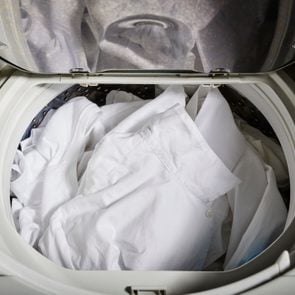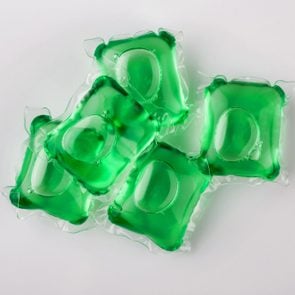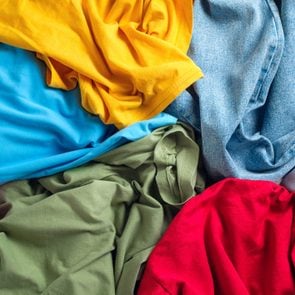How to Wash Your Towels to Keep Them Clean and Fluffy
Updated: Apr. 18, 2024
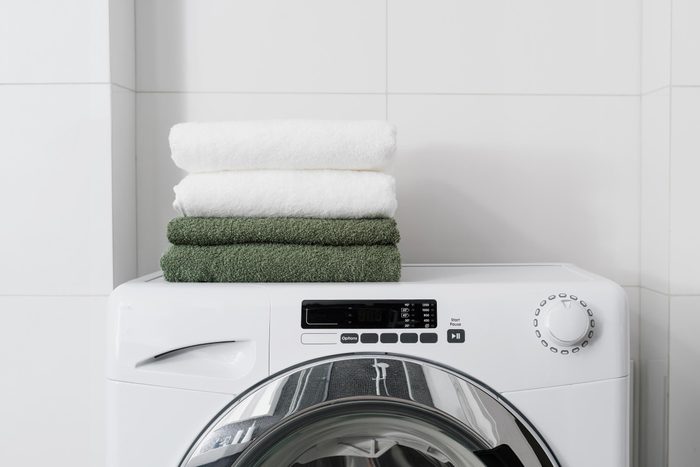
Want to keep your towels plush, absorbent and feeling brand new? Laundry experts explain how to wash towels the right way.
Nothing beats the feeling of wrapping yourself up in a soft, luxurious towel. And while it may seem simple, knowing how to wash towels properly is truly the gift that keeps on giving—not only does adding proper towel-washing to your cleaning schedule keep them clean and odor-free, it will also extend the life of your towels.
Even if you’re well-versed in how to do laundry properly, keeping towels fluffy and soft after every wash requires a new level of mastery. To prevent our best towels from turning raggedy, limp or scratchy, we spoke to four fabric-care and cleaning experts, including two specializing in laundry care and two pathology and microbiology specialists (because towels can be a harboring ground for bacteria). They’re explaining how to wash towels the right way—and just how often you should be doing it. Read on for everything you need to know about how to clean bath towels and keep them plush for the long haul.
Get Reader’s Digest’s Read Up newsletter for more cleaning, humor, travel, tech and fun facts all week long.
About the experts
Reviewed for accuracy by: Mary Marlowe Leverette, a highly regarded fabric-care, stain-removal and housekeeping expert with more than 40 years of experience. |
How often should you wash your towels?
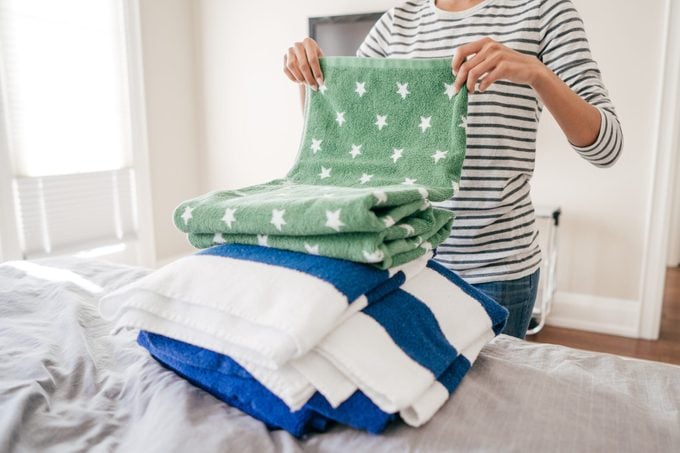
You should wash your towels every two to three days, according to both Philip Tierno, PhD, clinical professor of pathology and microbiology at the NYU Grossman School of Medicine, and Chuck Gerba, PhD, a microbiology professor at the University of Arizona. If you hold out longer than that, bacteria can start to build up on your towel, leaving it dirty and possibly even smelly. (That musty scent is a telltale sign things have gone south.)
If you have sensitive skin or are acne-prone, then you might want to wash your towel every time you use it, says Tierno, rather than waiting a day or two between washes. As you rub your skin with a dirty towel, bacteria from your used towel could spread across your skin, causing buildup and creating breakouts—especially if it’s already inflamed.
One caveat to the washing schedule is if you have a heated towel rack. Because heated towel racks speed up dry time, you can get away with washing it after four uses. But that’s still “pushing it,” says Tierno.
Why it’s important to wash your towel regularly
Beyond leaving your towels smelling fresh and clean, experts say washing them regularly is important for a number of other reasons.
- It minimizes the growth and buildup of bacteria. You only use your towel after scrubbing off in the shower, so it can’t be all that dirty, right? Not so fast. “When you say you wash off bacteria, you’re partially correct—you wash off some bacteria,” says Tierno. But some bacteria sticks around, and it gets on your towel during your post-shower rubdown. Once that bacteria is on there, it will start to multiply. “It keeps building up as you use the towel again day after day,” says Gerba.
- It reduces the risk of infection and acne. “When you use a towel vigorously, you scratch your skin,” says Gerba. Those tiny breaks in the surface of your skin—which are too small to notice—give bacteria from a dirty towel an entryway to get in your body, which could result in pimples or, worse, an infection.
- It nixes musty odors. When bacteria builds up on your towel, it can start smelling musty or mildew-y, and there’s nothing pleasant about that. The scent can then transfer onto your body, counteracting your shower.
- It keeps towels fluffy and absorbent. Because the towel fibers have more air between them and aren’t matted down, freshly laundered towels work better at absorbing liquid—and isn’t that the whole purpose of a towel?
Supplies you’ll need
If you want clean and fluffy towels, make sure you have the following supplies on hand. And great news: You don’t need a special laundry detergent for towels. Our experts say your preferred detergent will do the trick. However, you’ll want to reduce how much detergent you use because both Sammy Wang, senior scientist at Downy, and laundry expert Wendy Saladyga warn that using too much in your laundry loads can lead to towels that feel stiff or scratchy.
- Preferred laundry detergent
- Fabric softener (optional)
- Dryer balls (optional)
- Vinegar (optional)
How to wash towels
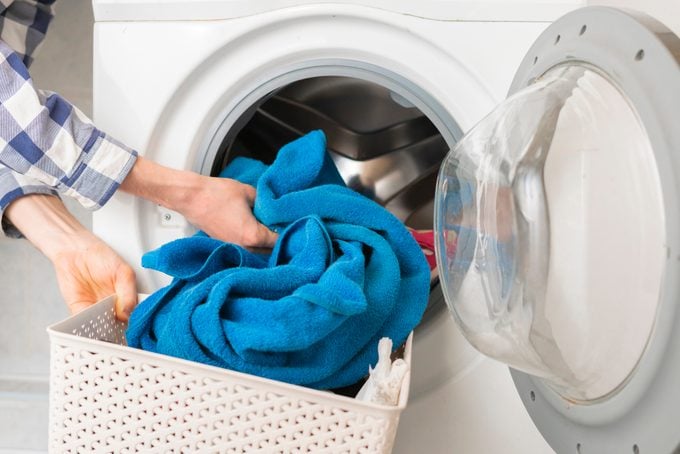
According to Wang and Saladyga, the process is very similar to how you’d wash anything else. But there are a few differences. First, you’ll want to make sure you’re only washing towels in the load and you’re separating white towels from colored towels. And second, while you should always read the detergent’s on-label instructions, if you find that your towels aren’t fluffy anymore, note that towel loads typically require less detergent. Always consider fabric type and color and always refer to the laundry care instructions on the towel’s label, which may call for specific temperature settings and ingredients. Follow these expert-approved towel-washing steps.
Step 1: Separate laundry
Separate your towels from the rest of your laundry, says Wang. “This prevents pulling or snags from clothing hardware like zippers,” she says. From there, separate colored towels and white towels to avoid bleeding. Towels should always be washed with similar materials, advises Saladyga, which helps keep them fluffy.
Step 2: Add your laundry to the machine
According to Saladyga, it’s important to avoid overloading the machine with towels, which can hinder the washing process and potentially damage your appliance. “There should be at least six inches between the towels and the top of the washer drum,” she says.
Step 3: Pour only half the amount of detergent
Stiff, scratchy towels? That may be a sign you’re using too much detergent. Add about half the amount of detergent as usual, Wang says. Using too much detergent can cause buildup on your towels and may potentially reduce their absorption abilities too.
Step 4: Add a fabric softener (every three to four washes)
“Towels absorb and hold onto residues and can become stiff or musty due to hard-water residue and other buildup,” says Wang. “So using a fabric rinse on towels can be especially beneficial.” Choose one with odor-removing benefits and follow the on-label instructions. While some brands may recommend you use it every wash, others may suggest a less frequent schedule—for instance, some fabric softeners actually endure through several washes, so you only need to include this step every three to four wash cycles.
Step 5: Wash in the right temperature
Saladyga says that washing towels at the incorrect temperature can compromise their fluffiness. The most suitable setting to wash your towels will depend entirely on their fabric type, so before choosing a temp, make sure to read your towel’s care label.
You may also want to check the detergent’s directions—while many detergents work best in warm water, some recommend cold water settings.
How to dry towels
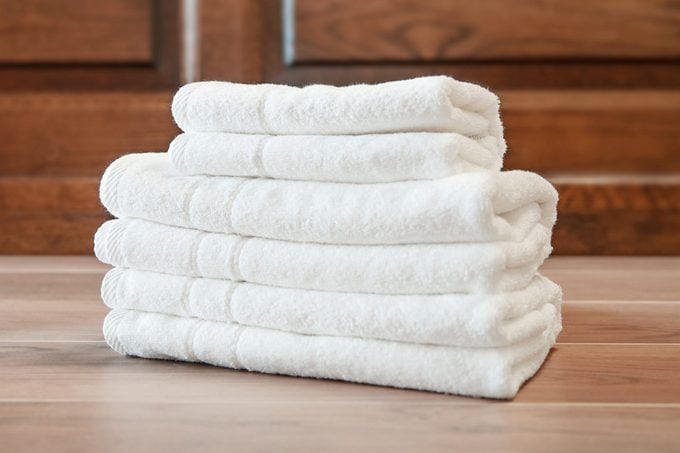
Properly drying your towels (on the correct dryer setting) can impact their fluffiness, as well, say both Wang and Saladyga. When it comes to towel drying, our pros recommend using a dryer versus air-drying. Follow these simple steps.
Step 1: Transfer immediately
“My tried and true [method] is removing towels from the washing machine as soon as the cycle has ended,” Saladyga says. “Wet towels left in the machine may start smelling musty and need to be washed again. If you still see stains, try pre-treating and washing again before drying.”
Step 2: Shake the towels
Time to boogy! Well, kind of. Remove towels from the washing machine one-by-one and shake out each before putting it in the dryer. This loosens up the fabric’s loops and helps with drying and fluffiness.
Step 3: Dry on medium to low heat
Dry towels on medium to low heat until they’re completely dry, since any remaining moisture can cause mildew. That said, Saladyga warns against over-drying, which can damage the fabric fibers with time. “Dry in full loads, but don’t overload the dryer. This may prevent your towels from drying completely,” Saladyga advises. And for extra credit, use dryer balls to make towels super fluffy and to avoid twisting and clumping.
Step 4: Remove and shake more
Remove towels from the dryer immediately and shake them out again to ensure fluffiness before hanging or folding for storage.
How to wash towels with vinegar
If your freshly laundered towels smell musty, vinegar may be your new best friend. Here’s what Wang recommends for effectively using vinegar to clean towels.
Step 1: Soak towels in vinegar
“Because of its chemistry and the large amount of water used in the laundry process, vinegar is actually most effective when used as a vinegar soak,” Wang says. “It contains acetic acid that can help break up mineral deposits and dissolve the buildup of body soils on your towels.”
She advises soaking towels in a bucket of white distilled vinegar for 30 minutes to overnight. As an alternative, add 1/2 to 1 cup of white vinegar to the rinse cycle. Either process will help deodorize your towels and remove any detergent buildup that could be affecting their absorbency.
Step 2: Wash in the machine
Place your towels into the washing machine’s drum and add a high-quality laundry detergent. You can also use a fabric softener every three to four washes.
Step 3: Dry
Follow the same instructions above for drying your towels. This includes transferring them immediately, shaking each towel and not overloading or over-heating.
Additional towel-washing tips
Knowing how to wash towels will only get you so far. These tips will take your laundry game up another notch and ensure that you don’t make an all-too-common mistake.
- Don’t mix towels and clothing. Whenever possible, don’t mix bath towels with your normal clothing loads. This helps extend the life of your towels by reducing the risk of pulled threads that can get caught on buttons or zippers.
- Wash new towels before using. Towels are often coated with silicone to make the fabric look and feel great in stores. However, these coatings can make your towels less absorbent, which is why laundering them first is a good idea.
- Air-dry towels between uses. Allowing your towel to air-dry fully cuts down on bacteria growth, according to Tierno. Instead of folding it, leave it open and drape it on the rod. The more surface area that’s exposed to the air, the better it will dry.
- Remove towels from the dryer right away. The secret to the fluffiest towels is not letting them sit in the dryer. The fibers will have more fluff and air between them if you remove them promptly.
- Dry towels on low heat. Want to make towels last? Low heat is the key. With time, high heat can damage towel fibers and decrease their life span.
Why trust us
At Reader’s Digest, we’re committed to producing high-quality content by writers with expertise and experience in their field, in consultation with relevant, qualified experts. For this piece, Maryn Liles tapped her experience as a longtime home and lifestyle writer. Then fabric-care and stain-removal expert Mary Marlowe Leverette gave it a rigorous review to ensure that all information is accurate and offers the best possible advice to readers. For this piece, we relied on reputable primary sources, including cleaning and health experts and reputable organizations. We verified all facts and data and backed them with credible sourcing, and we will revisit them over time to ensure they remain accurate and up to date. Read more about our team, our contributors and our editorial policies.
Sources:
- Sammy Wang, senior scientist at Downy for Proctor & Gamble; interview, January 2024
- Wendy Saladyga, stain expert and senior manager of technical performance for Persil Laundry and All Laundry; interview, January 2024
- Philip Tierno, PhD, clinical professor of pathology and microbiology at the NYU Grossman School of Medicine; interview, September 2021
- Chuck Gerba, PhD, microbiology professor at the University of Arizona; interview, September 2021
- Food Protection Trends: “Bacterial occurrence in kitchen hand towels”

